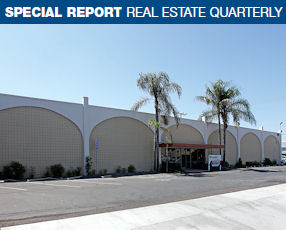By one measure, the fourth quarter industrial market in the greater San Fernando Valley region was brutal. Sales and leasing activity was off by 30 percent compared to the third quarter – and more than 60 percent from a year earlier. And with numbers like that, landlords worked hard to close deals. Consider what Rexford Industrial LLC went through in November to lease an older 76,993 square-foot industrial building in San Fernando as a distribution hub for PureTek Corp., a pharmaceutical manufacturer in the area. The Los Angeles developer added five new loading docks, skylights and an energy-efficient lighting system to the 1050 Arroyo St. building, which had sat empty after serving as a plastic injection molding facility for Samco Scientific Corp. “As the business makeup of the industrial market moves away from aerospace and manufacturing to a more distribution type of economy, we’re seeing (tenants) wanting newer buildings and higher interior clearance,” said Chad Gahr, vice president at NAI Capital Inc.’s Encino office, who represented Rexford. “They’ll pay a higher price, but they’ll want things that make it suit that purpose. Landlords are looking at older properties and how to give them a new functionality.” Gahr declined to give lease details, citing a confidentiality agreement. Howard Schwimmer, a co-founder and senior managing partner at Rexford, says renovations like the one his company did on Arroyo Street are happening more often. “This really is a theme with development in the Valley,” he said. “We’re taking this sort of value-add approach. We can give them better loading and better space. We’d love to be buying more in the San Fernando Valley, but there just isn’t a lot available.” That kind of dynamic helps explain the fourth quarter data. Even though sales and leasing fell to under 1 million square feet – after hitting nearly 1.5 million in third quarter and 2.9 million in the fourth quarter of 2011 – asking rents still rose two cents to 57 cents a square foot, according to Jones Lang LaSalle Inc. Also pushing up rents: what little sales and leasing went on chewed up space. That was reflected in a vacancy rate that fell one tenth of a point from the third quarter to 4.9 percent. And with a shortage of attractive product, some new projects got a start. A joint venture of Newport Beach developer Shubin Nadal Associates LLC and Penwood Real Estate Investment Management LLC of Hartford, Conn. purchased 17 acres of land in Van Nuys for $13 million in November. The land housed laboratories vacated by Quest Diagnostics Inc. They are soon to be bulldozed to make way for three new spec warehouses costing $32 million. “The challenging thing in (the Valley) is infill,” said Nigel Stout, executive vice president at Jones Lang LaSalle’s Santa Clarita office. “So it’s about recycling existing sites.” Still selective Another option for companies is to simply have buildings constructed to their exact needs. In December, Scannell Properties, an Indianapolis developer, delivered 230,000 square feet to the market when it completed a new build-to-suit property in Pacoima. Occupied by a FedEx Corp. distribution center, the property was built to specifications that included more than 100 loading docks. While build-to-suit is desirable for some companies, others don’t want to wait the time it takes to finish such projects. “The vacancy rate is still really low. There are no buildings available over 100,000 square feet, so there’s a shortage and that falls down to the build-to-suit market,” said Stout. “But that takes a unique type of company who can look two years out and wait.” Instead, many companies took smaller buildings, including in the tight Central Valley area surrounding Van Nuys where smaller companies took Class B and C spaces that required upgrades rather than move away from existing employee bases. Less desirable properties in outlying areas not close to major transportation arteries have seen a slower comeback. In particular, the Conejo Valley communities of Camarillo and Westlake Village continue to suffer from their distance from a major transportation hub, according to brokers. “Large distributors have faced high fuel costs and that’s been a concern in going out that way,” said John DeGrinis, senior executive vice-president at Colliers International’s Encino office. “We clearly see those large buildings struggle because of that fact.” Still, the outlying areas may do better in the coming months, if the economy continues to strengthen and demand outweighs supply in the central markets.
